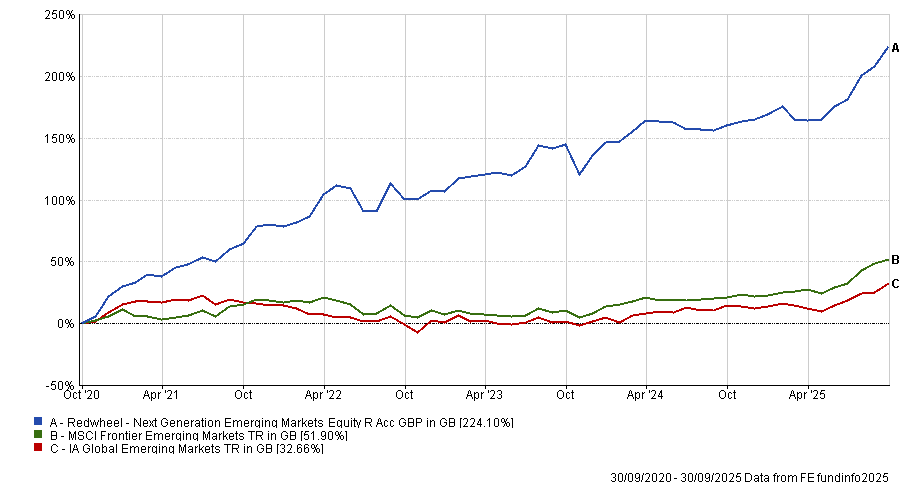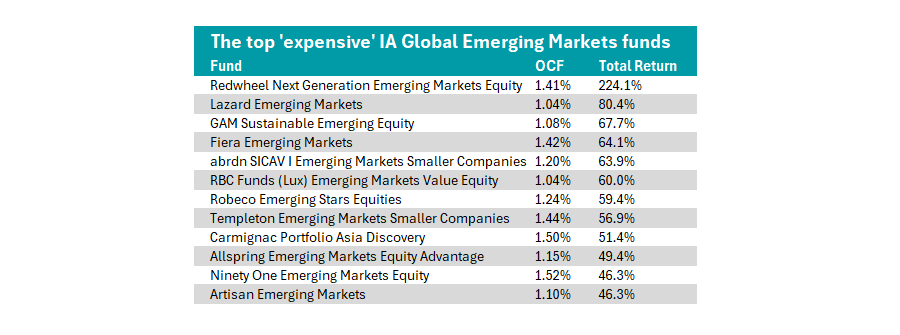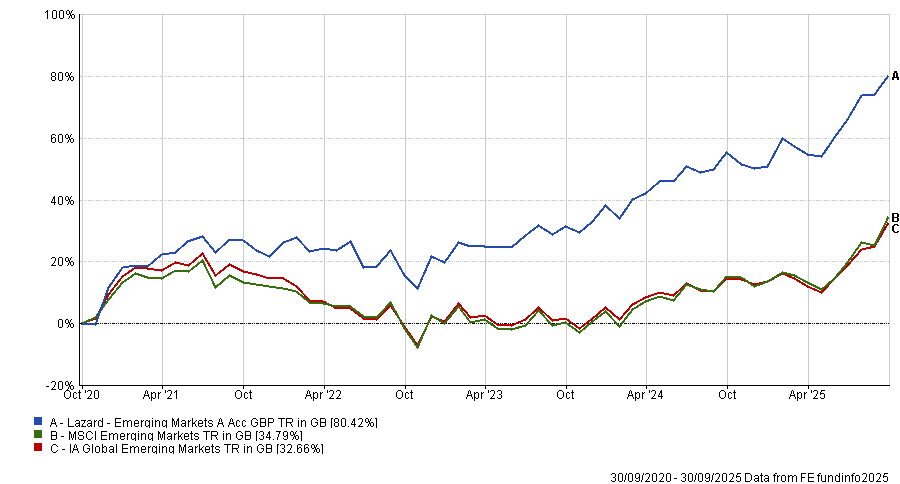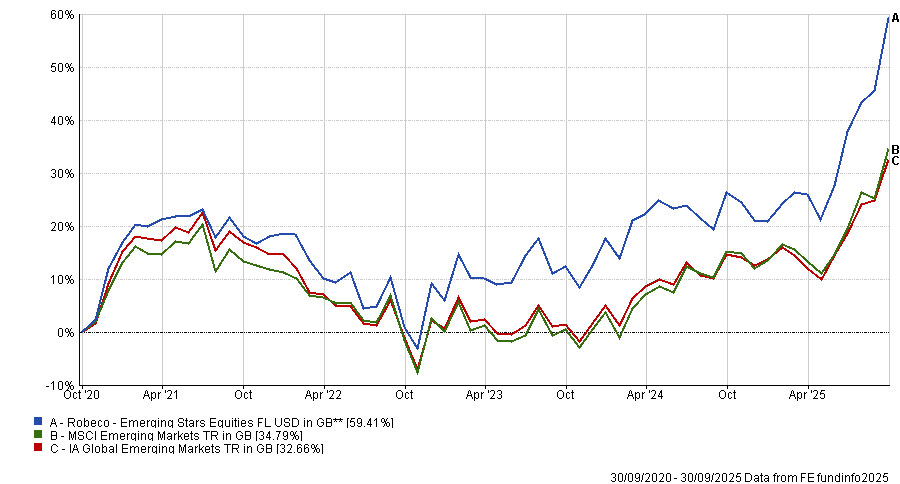Redwheel Next Generation Emerging Markets Equity has been the standout performer among emerging funds over the past five years, tripling investors' money in half a decade.
This rapid rise is almost double the next-best fund (up 136%) and more than double the third-highest returning portfolio (96.4%).
While these returns are all after fees, investors would have had to pay up for this performance. With an ongoing charges figure (OCF) of 1.41%, it is the eighth-most expensive portfolio in the IA Global Emerging Markets sector.
Led by James Johnstone, it invests in 90 issuers across frontier and smaller emerging markets, including South Africa, Vietnam and Indonesia, and has received an ‘A’ rating from Titan Square Mile.
Performance of fund vs sector and benchmark over 5yrs

Source: FE Analytics. Returns in sterling to the end of August.
Analysts at the ratings agency praised Johnstone’s experience running money in the region and pointed to the “well-resourced” team, which conducts macroeconomic research to help Johnstone build “conviction in bottom-up investment ideas”.
The team at Square Mile noted that, because these frontier markets are often “under-researched, under-represented and under-owned by international investors”, this strategy gives “significantly different exposure” from most other portfolios, even compared to other emerging markets.
However, due to the nature of investing in smaller parts of an already volatile universe, “performance is expected to be lumpier” with greater potential for volatile drawdowns, analysts continued.
It was one of 12 funds in the IA Global Emerging Markets sector to make strong returns despite higher fees of more than 1%, according to data from FE Analytics.

Source: FE Analytics. Returns in sterling to the end of August.
In second place is the Lazard Emerging Markets portfolio, up 80.4% after accounting for its 1.04% annual charge. The management team includes James Donald, Rohit Chopra, Monika Shrestha and Ganesh Ramachandra, who have worked on the strategy since 2007.
They invest at least 70% in equities of companies domiciled in the emerging markets or with a significant portion of their revenue in the region but can also invest in other investment vehicles managed by the Lazard team or a small portion of fixed-income securities.
Lazard Emerging Markets is currently most allocated to financial stocks (25% of the fund) and information technology stocks (18%), although the latter is an underweight compared to the benchmark.
The team at Rayner Spencer Mills Research (RSMR) favoured the strategy, highlighting the experienced and well-resourced team, as well as the bottom-up stock selection strategy, as key drivers behind strong performance.
“This approach is based on thorough stock screening and a process that involves various teams working together to produce stock ideas,” the analysts noted.
It has also managed to deliver strong returns over the medium term, although its 14% gain over the past 12 months is below the median peer.
Performance of fund vs sector and benchmark over 5yrs

Source: FE Analytics. Returns in sterling to the end of August.
A mirror strategy from the same stable, the Lazard Emerging Market Equity fund, also qualified with a 78% return and a 1.07% OCF. We have removed this from the table because it is unavailable to UK investors.
Robeco Emerging Stars Equity fund is the largest on the table above, with £2.5bn in assets under management (AUM). Managed by Jaap van der Hart and Karnail Sangha, it is up 59.4%, after deducting the annual 1.24% OCF.
Another strategy that incorporates both a bottom-up and top-down approach to asset allocation, the managers have a high conviction approach, with around 42% of the total portfolio invested in just their top 10 holdings. The largest position (Taiwan Semiconductor) represents almost 10% of the total portfolio.
Performance of fund vs sector and benchmark over 5yrs

Source: FE Analytics. Returns in sterling to the end of August.
It has been the third-best fund in the sector this year, with the managers attributing this to their top-down decision-making, including underweighting India and Taiwan and overweighting Brazil and South Africa, which paid off particularly in August.
“With the current America First focus, emerging markets are having to rely more on their own domestic policies and growth opportunities,” the managers recently noted.
They explained that most earnings in emerging market businesses are more domestically focused, meaning many companies should have the potential to outperform despite US tariff-related concerns.
Other high-cost emerging market strategies to deliver strong returns despite high costs include the GAM Sustainable Emerging Equity strategy, the abrdn SICAV Emerging Markets Smaller Companies strategy and the Fiera Emerging Markets strategy, among others.
This article is part of an ongoing series in which Trustnet examines the funds in Investment Association sectors that have posted top-quartile returns over the past five years, with relatively ‘expensive’ ongoing charges figures (OCF) of above 1%. Previously we have examined the Global, US, UK, European and Multi-asset markets.





